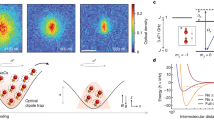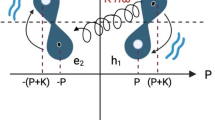Abstract
RECENT work1 on the effects of ionizing radiations on nucleic acids (deoxyribonucleic and ribonucleic acids) in aqueous systems has shown quite clearly that the reactive species produced from the water attack mainly the constituent purine and pyrimidine bases and, to a lesser extent, the sugar moieties of these polynucleotide molecules. The extents of destruction of the individual bases on irradiation of deoxyribonucleic solutions (0.005 per cent) in the presence of oxygen (1 atm.) were measured and found to be as follows (G = molecules/100 eV.) : G(− Δthymine) = 0.33 ; G(− Δadenine) = 0.25 ; G(− Δcytosine) = 0.23 ; G(− Δguanine) = 0.18. Breakage of the strands in the deoxyribonucleic acid helix is apparently mainly due to an attack of the radicals produced by irradiation on the sugar moieties, which leads to a splitting of the phosphate ester linkages along the chains. The extent of attack which leads to breakage of internucleotide bonds, leading to the production of phosphomonoester groups, has been determined directly with monophosphoesterase ; the number of end-groups formed on irradiation with 200 kV. X-rays gives a yield of G ≃ 0.5. Rupture of hydrogen bonds within the helix is a consequence of chemical changes in the polynucleotide chains ; several hydrogen bonds can be broken following a single chemical event.
This is a preview of subscription content, access via your institution
Access options
Subscribe to this journal
Receive 51 print issues and online access
$199.00 per year
only $3.90 per issue
Buy this article
- Purchase on Springer Link
- Instant access to full article PDF
Prices may be subject to local taxes which are calculated during checkout
Similar content being viewed by others
References
Scholes, G., Ward, J. F., and Weiss, J., paper presented at the Joint Meeting of the Faraday Soc. and Assoc. for Radiation Res. at King's College, Univ. of Durham, March 23–25, reported in Int. J. Radiation Biol., 1, 312 (1959). Ward, J. F., Ph.D. thesis, Univ. of Durham (1959).
Doty, P., and Zubay, G., J. Amer. Chem. Soc., 78, 6207 (1956).
Farmer, F. T., Stein, G., and Weiss, J., J. Chem. Soc., 3241 (1949).
MacNutt, W. S., Biochem. J., 50, 384 (1952).
Daniels, M., Scholes, G., and Weiss, J., Experientia, 11, 6, 219 (1953).
Kaufmann, B. P., McDonald, M. R., and Bernstein, M. H., Ann. N.Y. Acad. Sci., 59, 553 (1955).
Author information
Authors and Affiliations
Rights and permissions
About this article
Cite this article
EMMERSON, P., SCHOLES, G., THOMSON, D. et al. Chemical Effects of Ionizing Radiations on Nucleic Acids and Nucleoproteins. Nature 187, 319–320 (1960). https://doi.org/10.1038/187319a0
Issue Date:
DOI: https://doi.org/10.1038/187319a0
This article is cited by
-
The relationship between irregularities in the double-helical structure ofBacillus subtilis andBacillus brevis DNAs and their oscillopolarographic behaviour
Biophysik (1968)
-
Effect of γ-Radiation on Deoxynucleoprotein acting as a Primer in RNA Synthesis
Nature (1964)
-
Effect of Gamma-Rays on Thymus Nucleoprotein in Solution
Nature (1961)
Comments
By submitting a comment you agree to abide by our Terms and Community Guidelines. If you find something abusive or that does not comply with our terms or guidelines please flag it as inappropriate.



